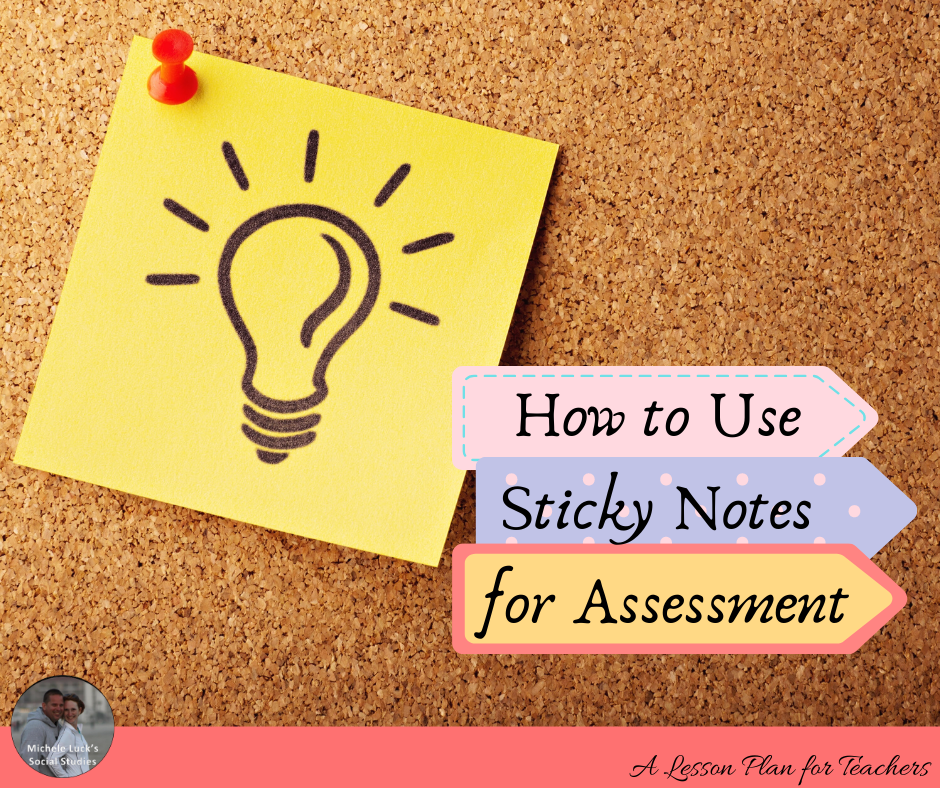Using sticky notes for assessment in the classroom may seem overly simple, but even first year secondary teachers are likely running out of fresh and exciting ideas for lesson planning. Instead of overthinking the next lesson or wracking your brain for new ideas, go back to the basics with sticky notes!

Sticky notes are the perfect lesson companion for middle school and high school classes because they’re inexpensive, you probably have a ton of them already lying around, and they are extremely versatile! Though it may seem like your options are limited with sticky notes, they really are limitless when it comes to “sticking” them into your lesson plans.
COLOR WARS. As sticky notes come in many different sizes and colors, they’re innately ideal for comparing and contrasting, categorizing, or differentiating. You can use sticky notes of the same color or size to highlight similarities or group things by likeness. You can use differently-colored sticky notes to bring attention to differences or separate unlike items. By using them for the most basic of tasks, sticky notes can make the repetitive process of searching for comparative qualities easy and fun. Students could even compile their sticky notes onto a large big paper Venn Diagram or other group response display.
BIG IDEAS, SMALL SPACE. You can also use sticky notes to make a large, daunting assignment seem quick and easy, lessening anxiety among your students. Assigning an opinion writing prompt or response group activity may illicit groans from your class, but reinforcing that students focus on the important ideas by limiting their response to the small three-by-three square may ease the stress.
STICK TO EXIT. Instead of having students log their exit slip in their overflowing Interactive Notebooks, offer them reprieve from the three-ring binder by passing out sticky notes for exit slips. Students can stick their responses to the white board on the way out.
ANONYMOUS NOTES. Students could orchestrate a debate by anonymously picking a side and then writing out their evidence, support, or opinion. Have students draw someone else’s sticky note from a jar or hat to present an anonymous opinion to the class as part of a structured debate or lighthearted discussion group.
MATCHING GAME. Use sticky notes to match data points, such as populations of countries. Label large paper with country names and fill out that county’s statistics on each sticky note (i.e. sticky notes would hold population, primary language, life expectancy, etc.). For even more depth, have students use one color for all similar statistics (i.e. all population data is on a pink sticky note) so that when they compare countries against each other, they can easily compare related data. Alternatively, put all statistics from one region on one color of sticky notes and then have students identify which country matches their results!
MAP PINS. Instead of the traditional pushpin-on-map dynamic, switch it up with sticky notes! Have students label a post-it note with a country, region, state, etc., and stick it to the correct area on a large classroom map. Collectively, they can label a whole continent or region with everyone’s sticky notes. Use this activity with the complete Geography Introduction Unit which details the five themes of geography!
BAR GRAPH REPRESENTATION. While recording classroom data for comparison in a government or economics class, have students stack their sticky notes up the wall or board to form a bar graph, ensuring that your graph will show an accurate representation since each student’s sticky note is the same size. Use different color sticky notes to add additional dynamics to your data collection. For example, in a blended class, Freshman can use one color to record their favorite subject, and Sophomores can use a different color. Then, draw conclusions about each based on the data trajectory.
SHORT STUDY GUIDE. Allow your students a small reprieve from the stress of your next exam by giving them one sticky note for a cheat sheet. Better than an open book test, students will still have to study the information to find the most important bits to record on their small slip of paper.
TASK CARDS. Have students use sticky notes to flag important information on Gallery Walks like this Roaring 20s Walking Tour, where information is distributed around the room. Or, allow them to collect important information on sticky notes to organize their thoughts as they visit each walking tour stop.
Bonus Teacher Tip!
DISCOURAGE CHEATING. This one is more of a teacher tip than a specific exercise in itself, but if you find your classroom full of wandering eyes, read quiz questions aloud and have students record their multiple choice answers on a sticky note. With only a sticky note on their empty desk, you will be able to quickly scout out anyone who is using extra resources to answer the questions!

Ditch the complicated lessons for your next unit and replace your difficult plans with easy sticky note activities! Or, use sticky notes to replace a daily activity that you can utilize throughout the year (like the exit slip idea). Either way, let your middle school and high school students use this commonly-overlooked office supply to amplify their lessons and inspire their creativity and curiosity!
Happy Teaching,
